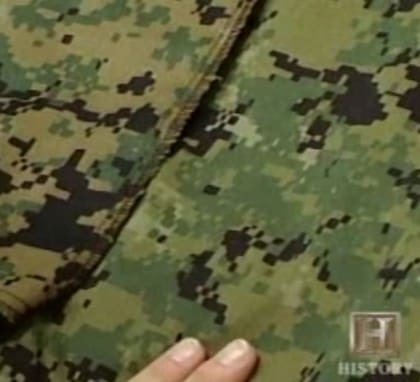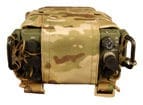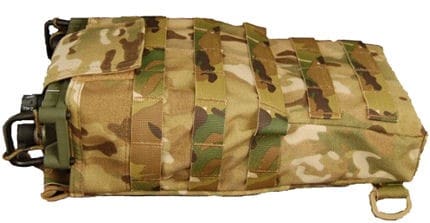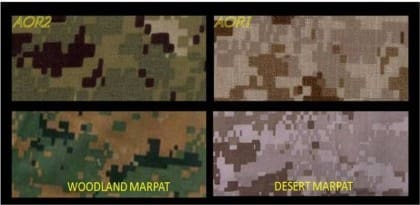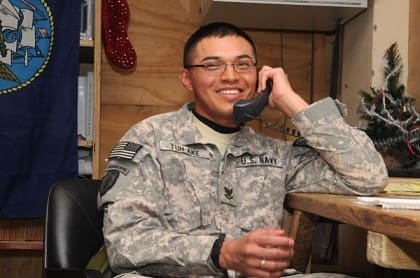The Navy has finally dealt with the issue of adopting proper uniforms for its ground forces in light of the fielding of the new Navy Working Uniform and its associated blue digital camo pattern optimized for hiding stains. Rumors had long surfaced that the mysterious AOR patterns would be adopted Navy wide for instances when Sailors would require camouflage uniforms for land combat effectively making the patterns naval in nature rather than dedicated for special operations use. Rumors also stated that the patterns would be altered ever so slightly with the addition of the Navy’s Anchor Constitution Eagle (ACE) design (see para 2). Apparently they were true on both counts or at least, sort of. Interestingly, the “Type II” or AOR 1 pattern will only be adopted by Naval Special Warfare and associated support forces. All other Sailors requiring desert camo will continue to use the current 3-color desert pattern first adopted almost 20 years ago during Operation DESERT STORM. Now it gets kind of confusing. The new “Type III” or AOR 2 pattern will be worn by ALL Navy personnel currently authorized.
Seems a little discombobulated. AOR 2 is fine for everybody, but AOR 1 will only be worn by NSW and that is AFTER the ACE is added to the pattern. Nothing like saying, “Hey, back off man, we’re Navy SEALs,” with your clothing. Also, sorry MAs. I had heard that you were going to be included in the new patterns but I guess it was not in the cards for you so keep on rocking those jaunty “Type I” NWUs.
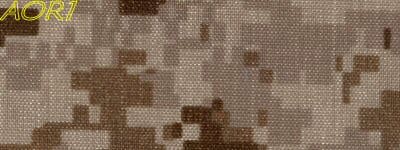
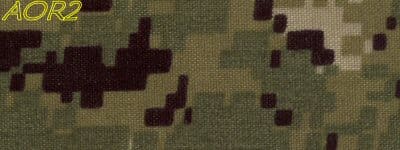
The official Navy message traffic is below.
UNCLASSIFIED//
ROUTINE
R 291203Z DEC 09
BT
UNCLAS
FM CNO WASHINGTON DC//N1//
TO NAVADMIN
NAVADMIN 374/09
MSGID/GENADMIN/CNO WASHINGTON DC/N1/DEC//
SUBJ/NAVY WORKING UNIFORM TYPE II AND III//
REF/A/MSG/CNO WASHINGTON DC/262243Z JUN 09//
REF/B/DOC/NAVPERS 15665I/01JAN2003//
NARR/REF A IS NAVADMIN 188/09. REF B IS U.S. NAVY UNIFORM REGULATIONS.//
RMKS/1. THIS NAVADMIN ANNOUNCES CHIEF OF NAVAL OPERATIONS APPROVAL OF THE NAVY WORKING UNIFORM (NWU) TYPE II AND III. THE NWU COLORING SCHEMES CONSIST OF TWO UNIQUE FOUR-SHADED DIGITAL CAMOUFLAGE PROFILES (DESERT AND WOODLAND) DEVELOPED BY NAVAL SPECIAL WARFARE (NSW) UNDER THE AUTHORITY AND GUIDANCE OF UNITED STATES SPECIAL OPERATIONS COMMAND FOR NSW AND MARITIME SPECIAL OPERATIONS FORCES. THE TACTICAL ADVANTAGE PROVIDED BY NWU TYPE II (DESERT) AND TYPE III (WOODLAND) DIGITAL PATTERNS WILL INCREASE PROBABILITY OF MISSION SUCCESS AND SURVIVABILITY IN COMBAT AND IRREGULAR WARFARE OPERATIONS DUE TO THE REDUCED VISUAL SIGNATURE IN THESE OPERATIONAL ENVIRONMENTS.
2. THE NWU TYPE II AND III ARE OF UNISEX DESIGN AND INCLUDES THE NAVY’S LOGO ANCHOR CONSTITUTION EAGLE (ACE) DESIGN IN THE PRINT OF THE FABRIC. THE NWU TYPE II AND III WILL UNDERGO CONFORMANCE TESTING DURING 2010 TO VALIDATE DESIGN, FIT, AND WEAR. A PHASED FLEET DISTRIBUTION WILL COMMENCE ONCE CONFORMANCE TESTING IS COMPLETE WITH PRIORITY DISTRIBUTION TO DEPLOYING COMBAT AND DIRECT COMBAT SUPPORT COMMANDS AND UNITS.
3. OCCASION FOR WEAR:
A. THE NWU TYPE II WILL BE WORN ONLY BY NAVY SPECIAL WARFARE (NSW) PERSONNEL, SAILORS ASSIGNED TO NSW UNITS, OR SAILORS ASSIGNED TO UNITS DIRECTLY SUPPORTING NSW MISSIONS WITHIN THE THEATER OF OPERATIONS. IN THE CONTINENTAL UNITED STATES, THE NWU TYPE II WILL ONLY BE WORN BY THE AFOREMENTIONED AUTHORIZED PERSONNEL ON TRAINING RANGES OR DURING ACTUAL OPERATIONS REQUIRING A DESERT CAMOUFLAGE UNIFORM. ALL OTHER COMMANDS AND INDIVIDUALS REQUIRING THE WEAR OF DESERT CAMOUFLAGE UNIFORMS WILL CONTINUE TO WEAR THE CURRENT TRI-COLOR DESERT CAMOUFLAGE UTILITY UNIFORM.
B. THE NWU TYPE III WILL REPLACE THE EXISTING TRI-COLORED WOODLAND CAMOUFLAGE UTILITY UNIFORM AND WILL BE THE STANDARD CAMOUFLAGE UNIFORM WORN IN CONUS AND CAN BE WORN DEPLOYED AS PRESCRIBED BY COMBATANT COMMANDERS. OCCASION FOR WEAR OF THE NWU TYPE III WILL BE THE SAME AS THE CURRENT WOODLAND CAMOUFLAGE UTILITY UNIFORM PER REF A, COMMANDS AND SAILORS CURRENTLY AUTHORIZED TO WEAR THE WOODLAND CAMOUFLAGE UTILITY UNIFORM (CUU) WILL CONTINUE TO WEAR THE CUU AS THEIR PRIMARY DAILY UNIFORM UNTIL THEIR TRANSITION TO THE NEW NWU TYPE III.
C. CNIC NAVY SECURITY FORCE SAILORS, TO INCLUDE AUXILIARY SECURITY FORCES AND RESERVE SECURITY FORCES, WILL WEAR NWU TYPE I (BLUE/GREY/BLACK) UNLESS ASSIGNED TO NSW COMMANDS AS OUTLINED IN PARAGRAPH 3A.
4. BASIC NWU TYPE II AND III COMPONENTS INCLUDE BROWN COTTON UNDERSHIRT, BLACK BOOT SOCKS, BLOUSING STRAPS, NAVY CERTIFIED DESERT TAN OR BROWN BRUSHLESS BOOTS, 1 1/4 INCH BLACK COTTON, NYLON OR ELASTIC WOVEN WEB BELT WITH BLACK TIP AND BLACK OPEN FACE BUCKLE OR 1 3/4 INCH WIDE BLACK OR TAN ONE PIECE ADJUSTABLE NYLON WEBBING RIGGERS BELT WITH FORGED STEEL BUCKLE,D-RING AND HOOK AND LOOP FASTENER, EIGHT POINT UTILITY CAP, UNISEX BLOUSE AND TROUSERS, EMBROIDERED COLLAR DEVICES (E4 AND ABOVE), SERVICE AND NAME TAPE.
5. PRESCRIBED NWU TYPE II AND III COMPONENTS INCLUDE MATCHING PATTERN WATERPROOF AND BREATHABLE FABRIC PARKA WITH REMOVABLE TAN FLEECE LINER AND SLIP ON RANK INSIGNIA FOR EXTREME COLD WEATHER SYSTEM (ECWS) PARKAS AND BLACK KNIT WATCH CAP.
6. OPTIONAL COMPONENTS INCLUDE SMOOTH BLACK LEATHER BOOTS, BROWN BOOT SOCKS, EARMUFFS (WITH OUTER-GARMENTS ONLY), EARRINGS (GOLD BALL FOR FEMALE E7 AND ABOVE AND SILVER BALL FOR FEMALE E6 AND BELOW), AND BLACK LEATHER GLOVES.
7. MANNER OF WEAR: THE MANNER OF WEAR OF THE NWU TYPE II AND III WILL BE CONSISTENT WITH THE CURRENT CAMOUFLAGE UTILITY UNIFORMS (DESERT AND WOODLAND) AS OUTLINED IN REF B. THE NWU TYPE II AND III WILL BE PROCURED AND ISSUED AS ORGANIZATIONAL CLOTHING AND WILL REMAIN THE PROPERTY OF THE ISSUING COMMAND.
8. PROGRAM MANAGEMENT AND TECHNICAL AUTHORITY FOR THE NWU TYPE II AND III IS ASSIGNED TO NAVAL FACILITIES ENGINEERING COMMAND (NAVFAC). PROGRAM MANAGER AND TECHNICAL AUTHORITY FOR THE DIGITAL CAMOUFLAGE PATTERNS IS ASSIGNED TO PROGRAM MANAGER SPECIAL OPERATIONS FORCES SURVIVAL, SUPPORT AND EQUIPMENT SYSTEMS (PM-SOF SSES), US ARMY SOLDIER SYSTEMS CENTER, NATICK AS DIRECTED BY NSW. DISTRIBUTION AUTHORITY OF THE NWU TYPE II IS ASSIGNED TO COMMANDER, NAVAL SPECIAL WARFARE COMMAND. ADDITIONAL INFORMATION REGARDING AVAILABILITY AND DISTRIBUTION OF THE NWU TYPE II AND III WILL BE ANNOUNCED VIA FUTURE NAVADMIN.
9. FILE THIS NAVADMIN UNTIL CHANGES ARE INCORPORATED INTO THE QUARTERLY BUPERS DIRECTIVE CD-ROM CHANGE CONTAINING REF A. IN THE INTERIM, FOR MORE INFORMATION ON UNIFORMS AND UNIFORM POLICY, VISIT THE NAVY UNIFORM MATTERS WEBSITE AT HTTP://WWW.NPC.NAVY.MIL/COMMANDSUPPORT/USNAVYUNIFORMS/.
10. POINTS OF CONTACTS:
Edited for PERSEC
11. RELEASED BY VADM MARK FERGUSON, N1.//


